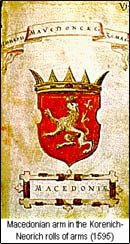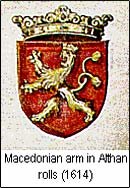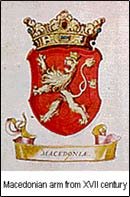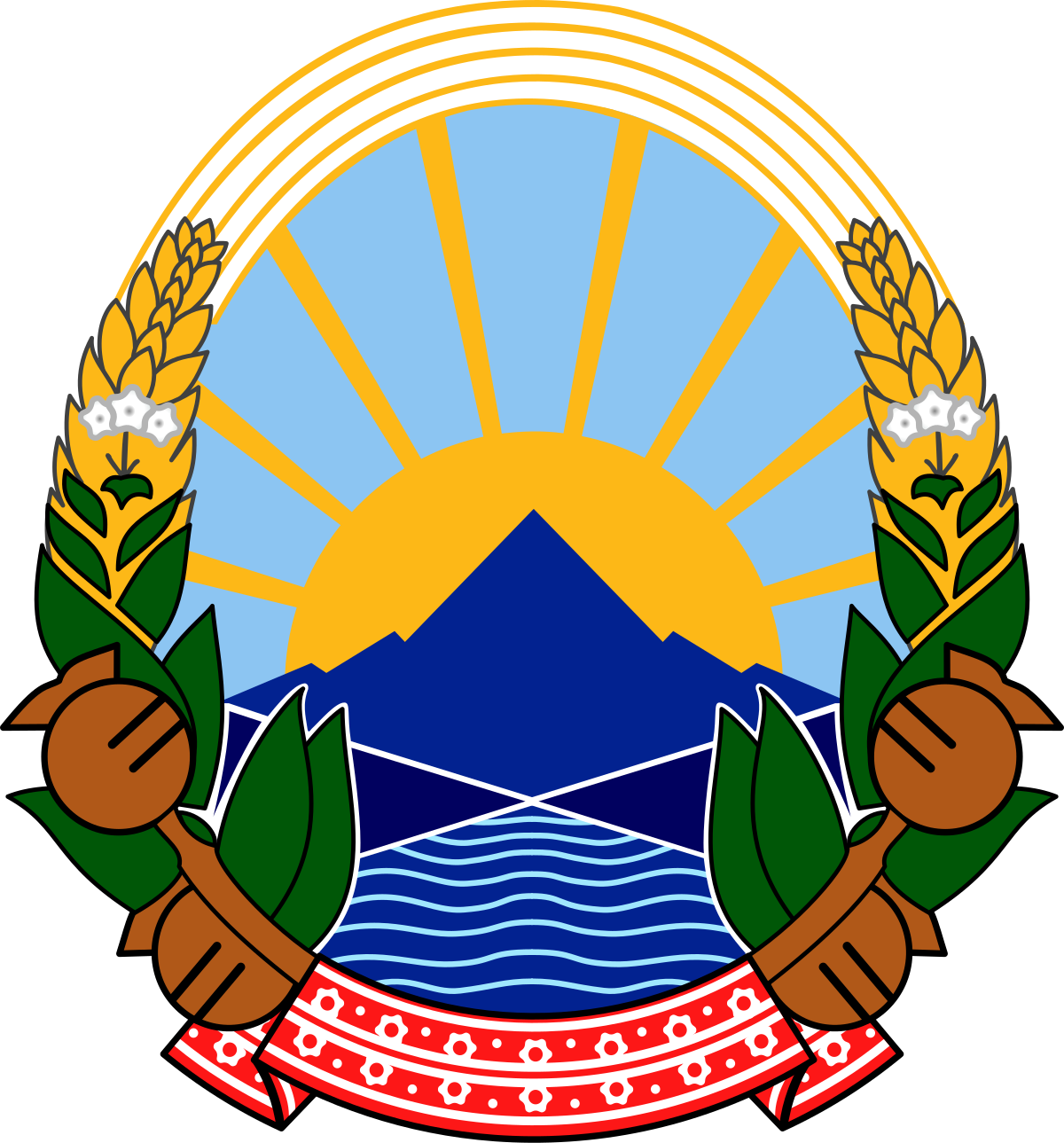COAT OF ARMS OF MACEDONIA
 In the course of the Middle Ages and in later periods the name of Macedonia can be found both in heraldry and itinerary literature. Macedonia is mentioned for the first time in the 1595 Korenič-Neorič rolls of arms, where the coat of arms of Macedonia is included among those of eleven other countries. As noted in detail by Aleksandar Matkovski, under the coat of arms is written "Macedonia", while above the arms in Cyrillic script is "Cimeri makedonske zemlje" (the Coat of Arms of the Macedonian country). In the Korenič-Neorič rolls of arms, Macedonian arms are presented along with those of Croatia, Dalmatia, Bulgaria, Bosnia, the Duchagyni, and Kastrioti; in the 152 coats of arms depicted, the Macedonian coat of arms with the inscription "Macedonia" is included twice. The same rolls of arms includes the arms of King Dushan or of his son Urosh. This is a complex coat of arms, presenting these kings as symbols of the unity of the South Slavs and including the arms of nine Balkan regions: Macedonia, Bosnia, Dalmatia, Croatia, the coastal countries, Slavonia, Bulgaria, Serbia and Rascia. Note that Macedonia is presented as a separate region.
In the course of the Middle Ages and in later periods the name of Macedonia can be found both in heraldry and itinerary literature. Macedonia is mentioned for the first time in the 1595 Korenič-Neorič rolls of arms, where the coat of arms of Macedonia is included among those of eleven other countries. As noted in detail by Aleksandar Matkovski, under the coat of arms is written "Macedonia", while above the arms in Cyrillic script is "Cimeri makedonske zemlje" (the Coat of Arms of the Macedonian country). In the Korenič-Neorič rolls of arms, Macedonian arms are presented along with those of Croatia, Dalmatia, Bulgaria, Bosnia, the Duchagyni, and Kastrioti; in the 152 coats of arms depicted, the Macedonian coat of arms with the inscription "Macedonia" is included twice. The same rolls of arms includes the arms of King Dushan or of his son Urosh. This is a complex coat of arms, presenting these kings as symbols of the unity of the South Slavs and including the arms of nine Balkan regions: Macedonia, Bosnia, Dalmatia, Croatia, the coastal countries, Slavonia, Bulgaria, Serbia and Rascia. Note that Macedonia is presented as a separate region.
In 1605, an extensive rolls of arms was published in Hungary. Siebmacher, its author, included the coat of arms-an single-headed eagle on a white background-of "Macedoniani", a Macedonian family from southern Hungary. Since the 15th century there had been a group of Macedonian immigrants in Baranya, inhabiting a village called Macedonia. The family Macedoniani originated from this village, where Dančo of Macedonia came from as well. Dančo is mentioned as early as 1439 as a rich noblemen; his descendants Ladislav of Macedonia, Bishop of Veliki Varaždin in 1533, and Volk of Macedonia, ban (governor) of Szörèny, are also noted.
One of the oldest preserved rolls of arms is that of Palinich, most likely prepared in the late 16th and early 17th century. The arms of Macedonia are included, with the hand-written Latin inscription "Macedonia regni" below it. The term Macedonia is also found in Althan's 1614 rolls of arms. Above the beautifully drawn Macedonian coat of arms is the Cyrillic inscription "Makedonske zemlje cimeri" and below that, in Latin, "Insignia regni Macedonia".
Among the most beautifully drawn Macedonian coats of arms is the one kept in the Museum of Applied Arts in Belgrade. This coat of arms, with the inscription "Macedoniae" belongs to the heraldry of King Dushan, along with arms of Illyria, Bosnia, Dalmatia, Croatia, Sklavonia, Bulgaria, Serbia and Rascia.
The Ohmuchevich family was known for its efforts to prove inheritance right over Bosnia and Macedonia. Over decades, the family tendered many claims to the territory, endeavoring to prove the rights of the Ohmuchevichs to large regions in the Balkans. They even printed coats of arms, wishing to prove their noble descent and their right to rule these large regions, Macedonia always taking the central place among them. Their enormous wealth made it possible for them to print heraldic collections and other books-which, regardless of the strength or validity of their claims to the territories-made the term "Macedonia" popular both in a geographical and an ethnic sense. The 1636 role of arms authored by Admiral Andriya Ohmuchevič and Marko Skoroevič argued that Macedonia and Bosnia could be liberated from Turkish rule only with the help of Vienna and the Hapsburgs. The Rolls of Arms of Marko Skoroevič was dedicated to Prince Ferdinand; though the young prince did not yet know to read, he could look at the "pictures" and by the help of the coats of arms grow familiar with the geographical terms and toponyms. The Macedonian coat of arms in this collection is included in a group of heraldries belonging to the South Slavic states, with the inscription "Insignia regni Macedonia" above it. On this coat of arms the lion is depicted standing rampant, yellow on a red background.
 The term Macedonia is also written below the Macedonian arms in the 1675 Foynitsa rolls of arms, as well as in Du Cange's 1680 History of Byzantium, published in Paris. Macedonian coat of arms containing the inscription "Macedonia" can also be found in the 1689 Olovo rolls of arms in Bologna. The Berlin rolls of arms from the late 1wth century also includes the term Macedonia written in Latin below the coat of arms. and "Cimeri makedonske zemle" above.
The term Macedonia is also written below the Macedonian arms in the 1675 Foynitsa rolls of arms, as well as in Du Cange's 1680 History of Byzantium, published in Paris. Macedonian coat of arms containing the inscription "Macedonia" can also be found in the 1689 Olovo rolls of arms in Bologna. The Berlin rolls of arms from the late 1wth century also includes the term Macedonia written in Latin below the coat of arms. and "Cimeri makedonske zemle" above.
In short, there are many records dating from the 17th century in which the term Macedonia is mentioned. It is also included in the handwritten 1694 stemmatographia of Pavle Riter Vitezovich: "Macedonia" is printed in Latin above the coat of arms. In the printed 1701 stemmatographia of Pavle Vitezovich, the inscription "Macedonia" is placed above the Macedonian coat of arms, while below there are four verses in Latin which tell that, in former times, the golden shields were symbols of imperial dignity, now replaced by a Turkish turbanned fez.
Hristofor Žefarovič, the most prominent Balkan artist of the 18th century, was Macedonian-born, most likely in Dojran. He was educated in Greek schools, but he acquired his artistic knowledge in Salonica and Ohrid. His Stemmatographia includes two rolls, one containing 56 coats of arms from all the Slavs and a second set of 20 containing South Slavic coats of arms. The Macedonian coat of arms is presented in both compositions with the inscription "Makedonia".
 The term "Macedonia" is also written below the Macedonian coat of arms in the 1746 rolls of arms of Ivo Saraka and in the third volume of Jovan Raich's rolls of arms, printed in 1794. Each coat of arms is labeled: the Macedonian as "Macedoniae", the Serbian as "Serbia", the Bulgarian as "Bulgaria" and the Bosnian as "Bosna".
The term "Macedonia" is also written below the Macedonian coat of arms in the 1746 rolls of arms of Ivo Saraka and in the third volume of Jovan Raich's rolls of arms, printed in 1794. Each coat of arms is labeled: the Macedonian as "Macedoniae", the Serbian as "Serbia", the Bulgarian as "Bulgaria" and the Bosnian as "Bosna".
The terms Macedonia and Macedonians were also recorded by travelers passing over its roads while travelling from East to West and vice versa, or while wandering over its territory. Historical misconceptions certainly had their effects on these travel accounts; the writers often named the Macedonians as Bulgarians, Serbs or Greeks.
But in many itineraries the terms Macedonia and Macedonians remained clearly distinguished from those for other Balkan states and other Balkan peoples. Thus, when the Venetian captain Angiolello passed through Macedonia and on August 13th, 1470 recorded his stay on the Holy Mountain, he wrote that "there are many Christian monks, some of whom are Greeks, others Macedonians, Vlachs, and there are even Italians and people from other nations." Four days later, while camping by the mouth of the Mesta River, he noted that "there live Greeks and Macedonians."
 An unknown author describes the Ohrid countryside, writing "Albania is the region which had been called Macedonia by the ancient peoples, i.e. it is a part of Macedonia, as Macedonia covers many countries and regions."
An unknown author describes the Ohrid countryside, writing "Albania is the region which had been called Macedonia by the ancient peoples, i.e. it is a part of Macedonia, as Macedonia covers many countries and regions."
In the 15th century, Bertrando de la Brokier traveled through the Balkans and left behind an account of his travels. Among other things, he writes "...and I remembered the heavy oppression of the Turk over the emperor in Constantinople and over all Greeks, Macedonians and Bulgarians, and even over the Despot of Rascia (Raška, as he referred to Gjuragj Brankovič) and all his subjects, which is very unfortunate for the all of Christianity.... And there are many Christians who are forced to serve the Turk, like the Greeks, Bulgarians, Macedonians, Albanians, Esklavonians, Rascians and Serbians...".
In 1461, some time after Brokier's travels through the Balkans, the Venician commissioner to Rome, Paulus Maurocenus, made plans to drive the Turks out of the Balkans: "...When the enemy forces are crushed, no one will ever doubt that all of Bulgaria, Serbia, Bosnia, Macedonia, Epirus, Thessaly, Greece or Athens, and Peloponnesus...".
In his 1547 itinerary of southern Macedonia, Pierre Bellon discourses on the Holy Mountain, the mines in Siderokapsa and Kavalla, and frequently refers to the region as Macedonia.
In his writings of 1573, the French traveler Philip du Fresne-Canais notes: "I saw a large plain at the beginning of which Skopje is located, hidden by small hills, a very big town which, according to some, is in Bulgaria, but according to my opinion is in Macedonia...".
In 1566 Yakov of Macedonia, a printer and a writer, left for Venice. There he printed a number of liturgical texts and other writings in the printing house of the Montenegrin voivoda (commander) Božidar Vukovič. In the preface to one of the liturgies he writes : "...I took great effort in making this work and in making holy books, for a long time and for many years... I came out from Macedonia, my homeland, and entered the Western countries...".
The printing of geographical maps stimulated the wider use of the term Macedonia. Many centuries passed from the first maps of Ptolemy, in which Ancient Macedonia is presented, to Peutinger's table, a maritime map depicting the coastline along the Aegean coast drafted by the Ottoman admiral and cartographer Pyrireis, to the map of the Macedonians in St. Petersburg. One of the more realistic geographical maps of Macedonia is Gastaldi's 1560 map published in Venice. It is there that certain Macedonian place names are adopted for the first time by the West: the Vardar River, Skopje, Skopska Crna Gora mountain, Tikveš Valley, Demir Kapija, Bitola, Kratovo, Struga, Ohrid and Ohrid Lake, Prespa and Prespa Lake, Prilep, Kostur, Lerin, Voden and Resen.
The Mercator map (Duisburg, 1589) and Laurenberg map (Amsterdam, 1647) followed Gastaldi's lead in giving some inhabited sites both their ancient and their contemporary Macedonian names, such as Lychnidos/Ohrid and Edessa/Voden. In Rome, G. Cantelli da Vigniola published a 1689 map which shows-with slight deviations-the territory of Macedonia and its geographical borders. Though map contains many errors, it for the first time marks the towns of Tetovo, Kumanovo, Katlanovo, Veles, Debar, Kavala, Ber and Enidze-Vardar (known as Pazar). Only seven years later, in Paris, N. Senson detailed Macedonia in a number of 1696 maps. These were followed by the maps of G. de L'Isle (Paris, 1707), Homann (1717), Harenberg (Nuernberg, 1741), S. Jenvier (Paris, 1750), A. Lapie (Paris, 1843), the Map of European Turkey (Belgrade, 1853), the commercial map of the province of Macedonia (Paris, 1885), and a "Map of Macedonia" by Dimitrija Čupovski (St. Petersburg, 1913) in which Macedonia is shown in its geographical and ethnic borders. On all these maps Macedonia is clearly labeled as Macedonia.